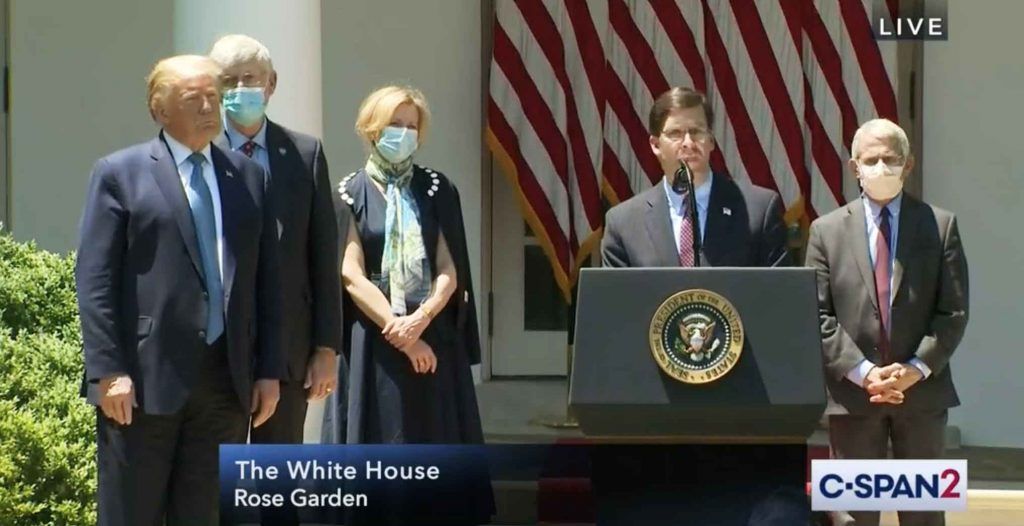Hear, see, speak no COVID: Why the Trump administration is bungling the response to the pandemic
By Saskia Popescu, Gregory D. Koblentz | June 18, 2020
 President Donald Trump at a press conference in May. Credit: C-SPAN.
President Donald Trump at a press conference in May. Credit: C-SPAN.
At the heart of the Trump administration’s bungled response to the coronavirus pandemic—from its early dismissal of the risks posed by COVID-19 to its failure to acquire sufficient personal protective equipment and diagnostic tests to its haphazard approach to reopening the economy—has been a refusal to properly utilize scientific expertise. As a result, the administration has had an incoherent response to one of the worst pandemics the world has seen since the 1918 Spanish Flu. The Trump administration’s “hear no COVID, see no COVID, speak no COVID” approach is in large part why the pandemic has already killed more than 100,000 people in the United States.
Hear no COVID. When the novel coronavirus SARS-CoV-2 emerged in China in December, warnings issued by scientists and public health officials inside and outside the government about the risks posed by the virus fell on deaf ears. Thanks to a reorganization of the National Security Council under John Bolton, there was no longer an office dedicated to global health security issues. When Rick Bright, director of the Biomedical Advanced Research and Development Authority, the US agency responsible for developing medical countermeasures against pandemics, started warning in mid-January that the United States needed to be better prepared, his concerns were dismissed as “commotion.” He was subsequently excluded from key meetings and eventually forced out of his position. One result of the failure to heed Bright’s increasingly urgent warnings and requests for more resources was a missed opportunity to boost domestic production of personal protective gear. As a result, health care workers still lacked sufficient quantities of such equipment months after the pandemic hit the United States.
The White House has also ignored advice from the Centers for Disease Control and Prevention (CDC), the nation’s premier public health agency, on matters large and small. The White House resisted the CDC’s recommendations on how to reopen the economy safely and ultimately issued guidance that was watered down and provided less detail to states. Since the White House guidance was released and as social distancing regulations have eased in many parts of the country, COVID-19 cases have spiked.
Trump also disregarded the advice of medical experts when he publicly touted the unproven health benefits of the anti-malarial drug hydroxychloroquine for the treatment of COVID-19. Even after a study demonstrated the lack of benefits and serious risks associated with this drug and the Food and Drug Administration (FDA) issued a warning against its use, Trump announced that he was taking hydroxychloroquine anyway. Once the FDA revoked its emergency use authorization for the drug, Trump criticized the decision and continued to promote the treatment.
Speak no COVID. The White House has not only refused to listen to expert advice, it has also prevented the government’s own experts from talking candidly to the public. Following a warning issued by CDC official Nancy Messonnier in late February that “the disruption to everyday life might be severe,” at a time when Trump was downplaying the risk of the outbreak, the White House “muzzled” the CDC and prevented it from engaging in its usual role of communicating directly with the media and public. The CDC was not allowed to hold a public briefing on the status of the pandemic and how Americans could protect themselves from COVID-19 for three months. Even when public health leaders like CDC director Robert Redfield and Anthony Fauci, director of the National Institute of Allergy and Infectious Diseases, were given a rare public forum, the president treated them more like props than public health experts. Trump frequently contradicted them and undermined their advice to the public about everything from the proper use of masks in public to the utility of social distancing to the availability of diagnostic tests. The White House’s contempt for public health expertise has filtered down to the local level. According to reporting, at least 27 local public health leaders in 13 states have been fired, resigned, or retired due in part to political opposition and public backlash.
Trump has filled the vacuum left by the absence of credible scientific voices with his own musings, and has used high-profile coronavirus task force press briefings to promote hydroxychloroquine, fantasize that COVID-19 would “go away”, and suggest the disease could be cured with injections of bleach or disinfectant. These false and dangerous statements have had real consequences, with a dramatic increase in the number of people reported being poisoned by these household chemicals after Trump’s comments. While there is evidence that foreign governments, such as Russia and China, are spreading disinformation about COVID-19 to cast the United States in a negative light, the sad reality is that more damaging disinformation has emanated from the Rose Garden than Red Square.
See no COVID. Trump’s refusal to accept bad news—frequently dubbed “fake news”—has hindered government efforts to gather the data needed to craft an effective response. As one headline put it, the United States is “driving blind” in the middle of the pandemic. The lack of urgency to replace or fix the CDC’s flawed diagnostic test early on in the pandemic coincided with a time when Trump was more worried about the politics and optics of the increasing number of positive cases in the United States than preventing the pandemic from spreading. In early March, Trump didn’t want to allow COVID-stricken passengers on board a cruise ship to disembark in the United States “because I like the numbers being where they are.” Even months into the pandemic, the president failed to grasp the fundamental importance of testing for public health, claiming, “If we didn’t do any testing, we would have very few cases.” Vice President Mike Pence recently told governors to blame recent surges in positive cases in their states on increased testing instead of the premature rush to reopen their states before the pandemic was under control.
The White House has a fixation on artificial testing metrics, such as the total number of tests conducted, which it wrongly equates with how effectively the United States is responding to the pandemic. In May, the CDC acknowledged combining the results of tests for active coronavirus infection and antibody tests showing past infections, making it difficult to assess the rate at which people were testing positive for COVID-19, an important consideration as states move to reopen different sectors. In addition, in its hobbled state, the CDC failed to establish uniform standards for how local and state health departments should collect and report data related to COVID-19. These missteps have given states such as Arizona and Florida an excuse to curtail the collection, analysis, and publication of COVID-19 data by health agencies. Compromising the integrity of this data not only corrupts the public health decision-making process, but also runs the risk of eroding public confidence in future guidance provided by health agencies. While taking short-cuts with data may serve short-term political and economic interests, it will have long-term consequences as policymakers and the public are deprived of the information they need to make informed choices.
The Trump administration’s hostility to science is not new nor limited to its approach to public health. This pandemic, however, has illuminated the costs of such an approach more immediately and dramatically than the long-term damage caused by the abandonment of science-based policies in areas such as air pollution, climate change, and environmental protection. According to researchers at Columbia University, if social distancing measures had been implemented more widely and strictly even one week earlier, approximately 36,000 lives could have been saved.
Groups such as the Nuclear Threat Initiative, the Federation of American Scientists, the Johns Hopkins Center for Health Security, and the COVID-19 Expert Database have stepped in to fill the void left by the Trump administration and provide the public and policymakers with access to scientific expertise and public health guidance. These are valuable initiatives but they cannot fully compensate for the sidelining of scientists within the federal government and the inability or unwillingness of federal agencies to issue evidence-based public health policies.
Despite Trump’s abdication of responsibility for many aspects of pandemic response, the federal government plays a crucial role in some areas, such as the development and distribution of vaccines and therapeutics. The administration’s repeated refusal to listen to scientists or make evidence-based decisions of public health import bodes ill for its highly touted Operation Warp Speed initiative to produce enough COVID-19 vaccine for all Americans by the end of 2020. For an endeavor that requires cutting-edge science, reams of data, and rigorous assessment of costs and benefits in the best of times, trusting this administration to shepherd the development of a safe and efficacious vaccine under such a compressed timeline and with such high stakes is reckless.
One of the key lessons learned from this pandemic is the importance of sound scientific advice and providing public health agencies with the independence to formulate and implement evidence-based policies to respond to threats to health security. The Trump administration has turned the gap between science and policy into a chasm. As Congress and the next administration consider reforms in the wake of COVID-19, rebuilding the federal government’s scientific expertise and integrity must be at the top of the agenda. Bridging the gap between science and policy will be necessary to prevent the next pandemic from becoming a public health catastrophe like COVID-19.
Editor’s note: A previous version of this article referred to the COVID-19 pandemic as the worst pandemic since the 1918 Spanish Flu. According to the World Health Organization, HIV, the first cases of which were reported in the United States in 1981, has killed 32 million people, a number that so far outpaces those for COVID-19. So far, there have been about 9 million confirmed cases of COVID-19. About 470,000 people have died, according to Johns Hopkins University.
Together, we make the world safer.
The Bulletin elevates expert voices above the noise. But as an independent nonprofit organization, our operations depend on the support of readers like you. Help us continue to deliver quality journalism that holds leaders accountable. Your support of our work at any level is important. In return, we promise our coverage will be understandable, influential, vigilant, solution-oriented, and fair-minded. Together we can make a difference.
Keywords: Coronavirus, Donald Trump
Topics: Biosecurity















